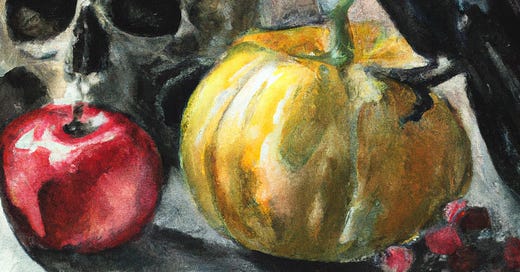"Writing Poetry and Thinking about Death"
My Queer Exvangelical American Life with Suicidal Ideation
Sometimes I like to quip that just like any other angsty repressed dyke, when I was sixteen, I spent my free time writing poetry and thinking about death.
But here’s another quip that I learned from my Russian friends and acquaintances decades before anyone had the slightest inkling that Russia would someday invade Ukraine: In every joke there’s a grain of joke.
No, that’s not a misprint. The point is that jokes themselves are a way of telling the truth. Specifically, jokes are a powerful vehicle for telling truths that are hard to speak directly, truths that scare us, truths that threaten prevailing social hierarchies.
In every joke there’s a grain of joke
Good comedy is always subversive in one way or another, and to be subversive, one has to tell the truths that society doesn’t want to hear. One has to go to dark places, observe the darkness, and use humor to bring what one finds in the darkness into the light. For many, it’s as much a means of coping with hardship and injustice, or with one’s own personal demons, as it is a means of entertaining one’s friends (or, for those who go bigger, of entertaining wider audiences).
The subject of humor’s power is worth an essay of its own, and I’m making a mental note now to revisit it at some point. But in this essay, I’m going to return to the “thinking about death” part of the opening paragraph, which is something my teenage self actually did do a lot of—and not just some about abstract and distant death, but specifically about killing myself. I also wrote a number of angst-filled poems (cringe if you must).
I even remember being on one date in that period of my life when, looking up at the night sky, I made some remarks about how “beautiful and tragic” human existence is (laugh at the stereotypical pseudoprofundity if you must). My date asked why tragic, and I couldn’t explain it—after all, evangelical Christian kids weren’t supposed to think this way, but intuitively it felt true to me. And the roots of this part of me go deeper and wider than being an introverted teenage nerd. Also, there was no second date.
Anyway, in last week’s essay here at The Bugbear Dispatch, “Orange County Communists and Other Impossible People,” I promised you a follow-up essay about suicidal ideation, and now I’m delivering. Suicidal ideation is quite a taboo topic, but I honestly think that if it were less so—less taboo, that is—we might see fewer people die by suicide. In addition, suicidal ideation is almost certainly more widespread than you think.

Keep reading with a 7-day free trial
Subscribe to The Bugbear Dispatch to keep reading this post and get 7 days of free access to the full post archives.



